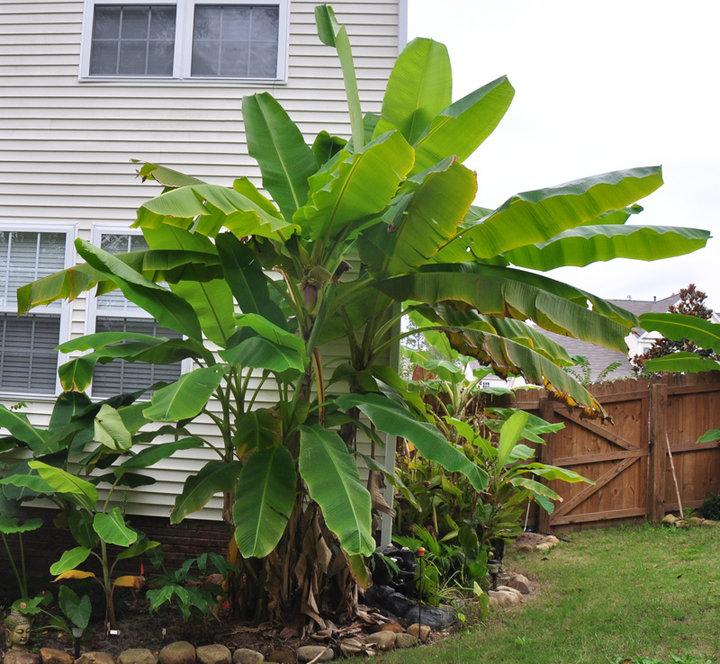The Ultimate Guide to Growing Musa Basjoo
Hardy Japanese Fiber Banana
Originating from the Ryukyu Islands of Japan, Musa Basjoo has found its way into the hearts and gardens of enthusiasts worldwide. What sets it apart is its remarkable resilience to cold, making it a popular choice for adding tropical flair to less-than-tropical locales.
Musa Basjoo is an incredibly hardy banana and is an excellent plant for adding that instant tropical splash to a yard. Musa Basjoo, aka the Japanese Fiber Banana, can be grown in all 50 states, withstanding temperatures down to 20 below F.
They'll also multiply (or pup) regularly, which gives you even more Basjoo to spread around. In zones above 7 the basjoo may die back to the ground each winter. But warmer zones 7-9 will typically see much of the pseudo-stem survive the winter above ground.

Musa Basjoo in Columbia, SC
Botanical Description
Musa Basjoo can soar to impressive heights of up to 15 feet or more, with broad, paddle-shaped leaves that can stretch up to 6 feet in length. The plant flaunts a lush green color, creating a dense canopy that sways gracefully in the breeze. Although it produces small, inedible bananas, the true appeal lies in its spectacular foliage and the golden-yellow flowers that precede the fruit.
Planting Guide
For optimal growth, plant Musa Basjoo in the spring, allowing it ample time to establish itself before winter. Choose a sunny spot with well-draining soil, enriching it with organic matter to encourage vigorous growth. Space your plants about 6 to 8 feet apart to give them room to spread.
Care and Maintenance
Watering is crucial, especially during dry spells, to keep the soil consistently moist but not waterlogged. A balanced fertilizer applied monthly during the growing season will support its rapid growth. Mulching helps retain moisture and protect the roots in cooler temperatures.
Overwintering Techniques
In colder climates, Musa Basjoo requires protection to survive the winter. Before the first frost, cut back the foliage and apply a generous layer of mulch around the base. Alternatively, potted specimens can be moved indoors to a cool, bright space until spring.
Pests and Diseases
Vigilance is key to preventing infestations of spider mites or aphids. Regular inspections and prompt removal of affected areas can help keep your plant healthy. Fungal diseases can be avoided by ensuring good air circulation and avoiding overhead watering.
Propagation Methods
Propagating Musa Basjoo is straightforward. Division of the root clump is the most effective method, best performed in early spring. Carefully separate the suckers from the main plant, ensuring each has a portion of the root system, and replant immediately.
Landscape Uses
Musa Basjoo is a versatile plant that can be used as a stunning focal point, in mass plantings for a lush, jungle-like effect, or as a natural privacy screen. Its rapid growth and large leaves create an instant impact in any garden setting.
Environmental Impact
While not considered invasive, it's important to be mindful of its vigorous growth. Musa Basjoo provides shelter and food for a variety of wildlife, making it a valuable addition to eco-friendly gardens.
Personal Experiences and Tips
Many gardeners find joy in the rapid growth and tropical aesthetic of Musa Basjoo. A common tip is to plant it alongside other tropical-like perennials such as cannas or elephant ears to create a themed garden bed that requires less maintenance but offers maximum visual impact.
Frequently Asked Questions (FAQs)
- Q: Can Musa Basjoo survive winter outdoors?
- A: Yes, with proper mulching and care, it can survive winters in zones 7 and above.
- Q: How fast does Musa Basjoo grow?
- A: It can grow up to 2 feet per month in optimal conditions.
Hardiness Zones
USDA Zone 5b: to -15 °F
USDA Zone 6a: to -10 °F
USDA Zone 6b: to -5 °F
USDA Zone 7a: to 0 °F
USDA Zone 7b: to 5 °F
USDA Zone 8a: to 10 °F
USDA Zone 8b: to 15 °F
USDA Zone 9a: to 20 °F
USDA Zone 9b: to 25 °F
USDA Zone 5a: to -20 °F
Plant Height
Height 8-10 ft.
Height 10-12 ft.
Height 12-15 ft.
Light Exposure
Light - 10% to 40% Shade
Light - Full Sun
Growth Rate
Rate - Very Fast
Rate - Fast


